暨南大学词汇学构词法考试
- 格式:docx
- 大小:18.34 KB
- 文档页数:10
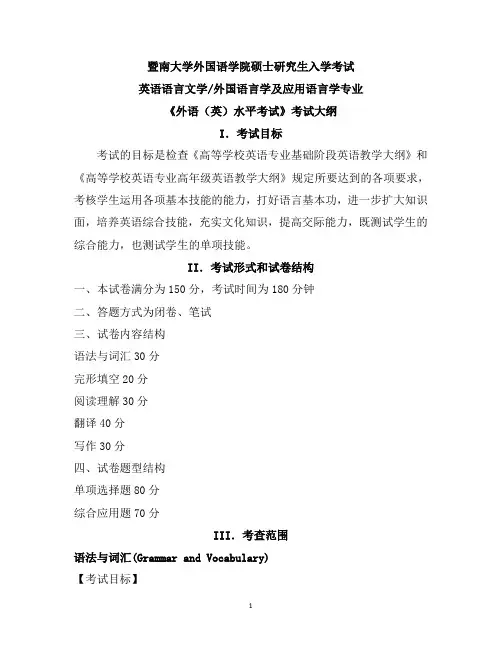
暨南大学外国语学院硕士研究生入学考试英语语言文学/外国语言学及应用语言学专业《外语(英)水平考试》考试大纲I.考试目标考试的目标是检查《高等学校英语专业基础阶段英语教学大纲》和《高等学校英语专业高年级英语教学大纲》规定所要达到的各项要求,考核学生运用各项基本技能的能力,打好语言基本功,进一步扩大知识面,培养英语综合技能,充实文化知识,提高交际能力,既测试学生的综合能力,也测试学生的单项技能。
II.考试形式和试卷结构一、本试卷满分为150分,考试时间为180分钟二、答题方式为闭卷、笔试三、试卷内容结构语法与词汇30分完形填空20分阅读理解30分翻译40分写作30分四、试卷题型结构单项选择题80分综合应用题70分III.考查范围语法与词汇(Grammar and Vocabulary)【考试目标】1.测试《高等学校英语专业基础阶段英语教学大纲》和《高等学校英语专业高年级英语教学大纲》规定所要达到的词汇短语及基本语法概念的熟练程度。
2.本部分采用多项选择题。
共30道题,每题1分,每题有四个选项。
题目中约50%为词汇词组和短语用法题,其余为语法结构题。
3.本部分题型从以下两种题型任选一种:(1)题目为留有空白的英文句子,采用多项选择题型,要求考生从题目所给的A、B、C、D四个选项中,选出正确答案。
共30小题(30分)。
(2)题目为单句中的词或词组划有横底线,要求考生进行替换选择,即从A、B、C、D四个选项中选出一个最佳替换词。
共30小题(30分)。
完型填空(Cloze)【考试目标】完型填空重在考察应试者的英语知识运用能力,包括语法、词、词组的搭配,语篇的照应,英语语言、文学、文化的基本知识等。
完型填空的基本命题形式是给考生一篇语句连贯的短文,命题者有目的地在每隔一定数量的词语后去除一处词语,形成总共20处词语空缺,然后在相应的空缺处设置包括三个干扰项在内的四个备选答案,然后需要考生从四个选项中选出一个最佳的答案。
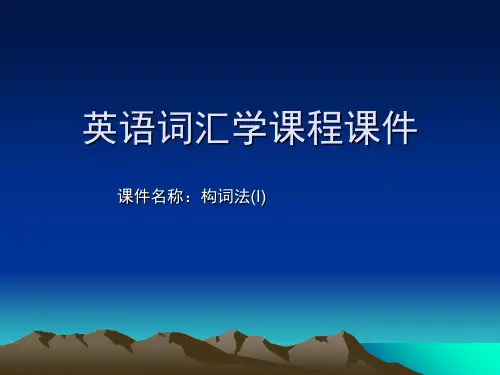
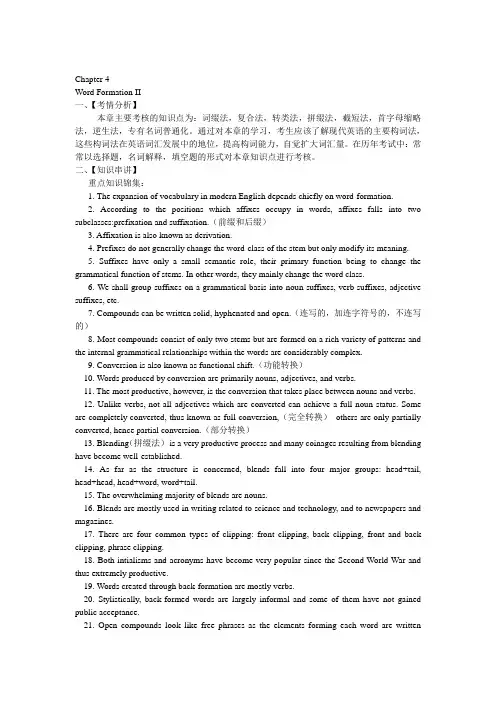
Chapter 4Word Formation II一、【考情分析】本章主要考核的知识点为:词缀法,复合法,转类法,拼缀法,截短法,首字母缩略法,逆生法,专有名词普通化。
通过对本章的学习,考生应该了解现代英语的主要构词法,这些构词法在英语词汇发展中的地位,提高构词能力,自觉扩大词汇量。
在历年考试中:常常以选择题,名词解释,填空题的形式对本章知识点进行考核。
二、【知识串讲】重点知识锦集:1. The expansion of vocabulary in modern English depends chiefly on word-formation.2. According to the positions which affixes occupy in words, affixes falls into two subclasses:prefixation and suffixation.(前缀和后缀)3. Affixation is also known as derivation.4. Prefixes do not generally change the word-class of the stem but only modify its meaning.5. Suffixes have only a small semantic role, their primary function being to change the grammatical function of stems. In other words, they mainly change the word class.6. We shall group suffixes on a grammatical basis into noun suffixes, verb suffixes, adjective suffixes, etc.7. Compounds can be written solid, hyphenated and open.(连写的,加连字符号的,不连写的)8. Most compounds consist of only two stems but are formed on a rich variety of patterns and the internal grammatical relationships within the words are considerably complex.9. Conversion is also known as functional shift.(功能转换)10. Words produced by conversion are primarily nouns, adjectives, and verbs.11. The most productive, however, is the conversion that takes place between nouns and verbs.12. Unlike verbs, not all adjectives which are converted can achieve a full noun status. Some are completely converted, thus known as full conversion,(完全转换)others are only partially converted, hence partial conversion.(部分转换)13. Blending(拼缀法)is a very productive process and many coinages resulting from blending have become well-established.14. As far as the structure is concerned, blends fall into four major groups: head+tail, head+head, head+word, word+tail.15. The overwhelming majority of blends are nouns.16. Blends are mostly used in writing related to science and technology, and to newspapers and magazines.17. There are four common types of clipping: front clipping, back clipping, front and back clipping, phrase clipping.18. Both intialisms and acronyms have become very popular since the Second World War and thus extremely productive.19. Words created through back-formation are mostly verbs.20. Stylistically, back-formed words are largely informal and some of them have not gained public acceptance.21. Open compounds look like free phrases as the elements forming each word are writtenseparately.22. As a rule, the stress of compounds falls on the first element.23. A compound functions as a single grammatical unit, so the internal structure can not be changed.24. Conversion(转换法)refers to the use of words of one class as that of a different class.25. Partial conversion and full conversion are concerned with adjectives when converted to nouns.名词解释:1. affixation(词缀法): Affixation is generally defined as the formation of words by adding word-forming or derivational affixes to stems.2. prefixation(前缀法): Prefixation is the formation of new words by adding prefixes to stems.3. suffixation(后缀法): Suffixation is the formation of new words by adding suffixes to stems.4. compounding(合成法): Compounding, also called composition, is the formation of new words by joining two or more stems. Words formed in this way are called compounds.5. conversion(转换法): Conversion is the formation of new words by converting words of one class to another class.6. blending(拼缀法): Blending is the formation of new words by combining parts of two words or a word plus a part of another word. Words formed in this way are called blends or pormanteau words.7. clipping(截短法): Another common way of making a word is to shorten a longer word by cutting a part off the original and using what remains instead. This is called clipping.8. acronymy(首字母拼音法): Acronymy is the process of forming new words by joining the initial letters of names of social and political organizations or special noun phrases and technical terms.9. initialisms(首字母缩略词): Initialisms are words pronounced letter by letter.10. acronyms(首字母拼音词): Acronyms are words formed from initial letters but pronounced as a normal word.11. back-formation(逆生法): Back-formation is considered to be the opposite process of suffixation. It’s therefore the method of creating words by removing the supposed suffixes.论述问答题:1. In what aspects do compounds differ from free phrases?答:Compounds differ from free phrases in the following three aspects:1). Phonetic features. In compounds the word stress usually occurs on the first element whereas in noun phrases the second element is generally stressed if there is only one stress.2). Semantic features. Compounds are different from free phrases in semantic unity. Every compound should express a single idea just as one word.3). Grammatical features. A compound tends to play a single grammatical role in a sentence, for example, a verb, a noun, or an adjective.2. What is the best way to classify prefixes? Why?答:Prefixes do not usually change the word-class of the stem but only modify lts meaning. Although present-day English finds an increasing number of class-changing prefixes, they make up only an insignificant number in the huge contemporary vocabulary. It might be the best way to classify prefixes by their non-class-changing feature.3. In what way are compound verbs generally formed? Give examples to illustrate your point.答:Compound verbs are created either through conversion or back-formation. This could be illustrated by two words, nickname and chain-smoker. Nickname, which is originally a noun, can be used as a verb through conversion. Chain-smoker, which is originally a noun, can turn into a verb through back-formation.4. What is the difference between partial and full conversion? Explain them with examples. 答:When converted to nouns, not all adjectives can achieve a full noun status. Some are completely converted, thus known as full conversion, others are only partially converted, hence partial conversion. When a noun fully converted from an adjective has all the characteristics of a noun, it can take an indefinite article or-(e)s to indicate singular or plural number. For example, adjective “white”can be fully converted to a noun “white”, which can take indefinite article: a white. When a noun partially converted from adjectives do not possess all the qualities a noun does. They must be used together with the definite article, and they retain some of the adjective features. For example, the poor, the rich.5. Both back-formation(逆生法)and back-clipping(截后留前)are ways of making words by removing the endings of words. How do you account for the coexistence of the two? Can you explain the difference?答:Back-formation is the method of creating words by removing the supposed suffixes. It’s considered to be the opposite process of suffixation. For example, “loafer”may be assumed to derive from the verb “loaf”’on the analogy of known derivatives, such as “swimmer” from “swim” or “driver” from “drive”. By removing the supposed suffixes –er from “loafer”, a verb “loaf”‟is coined. Majority of back-formed words are verbs. Back-clipping is different. The deletion occurs at the end of the word(usually a noun). Both the original long word and its short form remain in the same word class. In diffe rent context, one could be used in other‟s place.6. After he comes back, he oiled machine.In above sentence, which word is the converted word? Explain the type of the conversion and the effect of the conversion.答:In this sentence, the word “oil”is the converted word. It is converted from a noun to a verb. When it was used as a noun, the meaning of it is that “油”. But in this sentence, it was used as a verb, the meaning is “给…加油”; As is often the case, a noun can be converted to a verb without any change. The use of the verb converted is both economical and vivid.Chapter 5Word Meaning一、【考情分析】本章主要考核的知识点为:“意义”的意义,词义的理据,词义的类别。
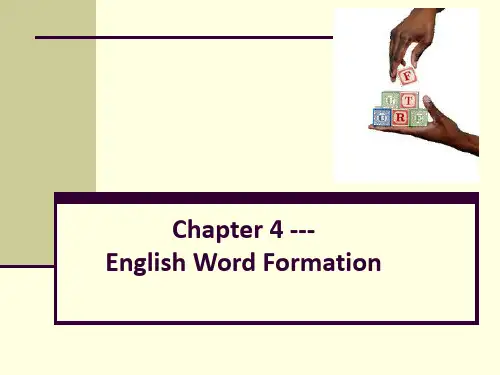
![考研真题:广东暨南大学2021年[汉语基础]考试真题](https://uimg.taocdn.com/8840dd2178563c1ec5da50e2524de518974bd377.webp)
考研真题:暨南大学2021年[汉语基础]考试真题一、汉语语言学基础知识(一)填空题1、语音题(每空1分,共2分)。
按要求回答:(1)“来”的声母是()(2)“来”的韵母是()。
2、语法题(每空1分,共4分)。
按要求回答:“小王已经拒绝了朋友的无理要求。
”选出这句话中的相应的句法结构:(1)主谓()(2)动宾()(3)状中()(4)定中()3、汉字题。
(每空1分,共3分)。
按要求回答:(1)“氧”字的部首是()。
(2)与“氧”部首相同的字常与()有关。
(3)与“氧”相同的字还有()。
4、古汉语题(每空1分,共3分)。
按要求回答:《铸五熟釜成与锺繇书》:“庶可赞扬洪美;垂之不朽。
”中“庶”的意思是();“垂”的意思是();“朽”的意思是()。
5、修辞填空题(每空1分,共3分)。
按要求回答:“对偶(明月松间照,清泉石上流)”最基本的三个条件:(1)()(2)()(3)()(二)判断题1、语法判断(共1分)。
按要求回答:“这家店的菜超好吃”中“超”是结果副词。
()2、词汇判断(共1分)。
按要求回答:“走马观花”中“走”的意思是“跑”。
()3、修辞判断(共1分)。
按要求回答:“盼望着,盼望着,东风来了,春天的脚步近了。
”中有拟人手法。
()4、语言学概论判断(每小题1分,共2分)。
(1)语法就是语言的结构规则。
()(2)世界上一切语言都有文字。
()(三)选择题1、语音题(每小题1分,共2分)。
(1)现代汉语“安”音节中a的发音用国际音标可记为()。
(2)现代汉语“羊”音节中a的发音用国际音标可记为()。
2、词汇题(每小题1分,共2分)。
她很犹豫是不是要跟先生一起去跑马拉松。
(1)上面这句话中,“犹豫”的语义是()。
(2)上面这句话中,“马拉松”的语义是()。
3、语法题(每小题1分,共2分)。
她很犹豫是不是要跟闺蜜一起去跑马拉松。
(1)上面这句话中,“犹豫”由()个语素构成。
(2)上面这句话中,“马拉松”由()个语素构成。


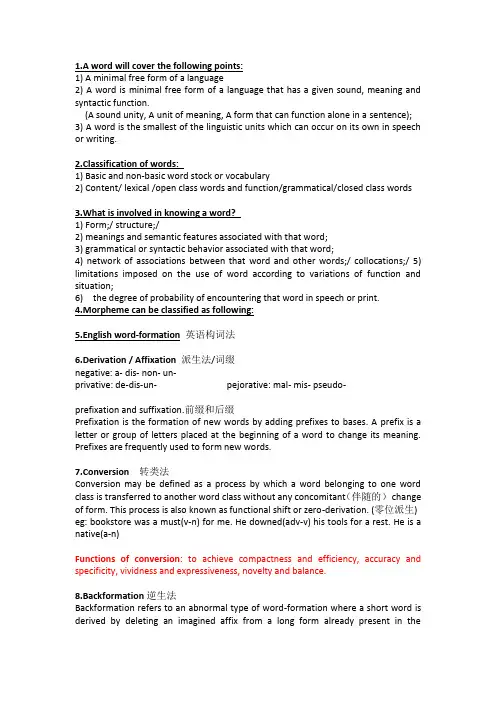
1.A word will cover the following points:1) A minimal free form of a language2) A word is minimal free form of a language that has a given sound, meaning and syntactic function.(A sound unity, A unit of meaning, A form that can function alone in a sentence);3) A word is the smallest of the linguistic units which can occur on its own in speech or writing.2.Classification of words:1) Basic and non-basic word stock or vocabulary2) Content/ lexical /open class words and function/grammatical/closed class words3.What is involved in knowing a word?1) Form;/ structure;/2) meanings and semantic features associated with that word;3) grammatical or syntactic behavior associated with that word;4) network of associations between that word and other words;/ collocations;/ 5) limitations imposed on the use of word according to variations of function and situation;6) the degree of probability of encountering that word in speech or print.4.Morpheme can be classified as following:5.English word-formation英语构词法6.Derivation / Affixation派生法/词缀negative: a- dis- non- un-privative: de-dis-un- pejorative: mal- mis- pseudo-prefixation and suffixation.前缀和后缀Prefixation is the formation of new words by adding prefixes to bases. A prefix is a letter or group of letters placed at the beginning of a word to change its meaning. Prefixes are frequently used to form new words.7.Conversion 转类法Conversion may be defined as a process by which a word belonging to one word class is transferred to another word class without any concomitant(伴随的)change of form. This process is also known as functional shift or zero-derivation. (零位派生) eg: bookstore was a must(v-n) for me. He downed(adv-v) his tools for a rest. He is a native(a-n)Functions of conversion: to achieve compactness and efficiency, accuracy and specificity, vividness and expressiveness, novelty and balance.8.Backformation逆生法Backformation refers to an abnormal type of word-formation where a short word is derived by deleting an imagined affix from a long form already present in thelanguage. This process is considered to be the opposite process of affixation. eg:bookkeeper<bookkeeping babysit<babysitting burgle<burglar lase<laser9.Abbreviation: 缩略法Abbreviation refers to word formation through clipping, initialism and acronym. These short forms are quicker and more convenient in use and for this reason they are becoming more and more popular.Clipping截短法Word formation by clipping part of a word, leaving only a piece of the old word. The shortening may occur at the beginning of the word, at the end of the word and at both ends of the word. The clipped form is normally regarded as informal. eg: phone(telephone), copter(helicopter), quake(earthquake) taxi(taxicab) appx.(appendix)Initialism首字母缩略词Words formed from the initial letters of words and pronounced as letters. VOA(Voice of America), p.c.(post card), VIP(very important person), BP(beautiful people)Acronym首字母拼音词ROM(read only memory), NATO(North Atlantic Treaty Organization), OPEC(Organization of Petroleum Exporting Countries )10.Blending 混词法Blending is the formation of new words by combining parts of two words or a word plus a part of another word. Words formed as such are called blends. Blends tend to be more frequent in informal style in the registers of journalism, advertising and technical field. Eg: head+tail:flaunt:flout+vaunt, blunt:blind+stunt, H-bomb:hydrogen+bomb, squash:squeeze+crash, hifi:high+fidelity/head+word:medicare:medical+care,/telequiz:telephone+quiz,//word+tail:workfare:work+welfare,bookmobile: book+automobile11.Imitation 基本拟声Zap! Crunch! Swoosh! The world is Whoa!12.Borrowing 外来语Coinage 新生词Invention 创造法poundingis a phenomenon where two or more existing words are combined to construct a new word. Compounding are useful to express the same meaning shortly and briefly and it can help writer to avoid repeating. E.g. The boy who catches attention is my son. The eye-catching boy is my son. The latter one expresses the same meaning more briefly and avoid repeating when we want to mention the boy afterwards. 14.Kinds of meaningConceptual meaning refers to the meaning of a word or lexical item that relates it to phenomena in the real world or in a fictional or possible world.Associative meaning Reflected meaning and collocative meaning, affective meaningand social meaning: all these have more in common with connotative meaning than with conceptual meaning, they all have the same open-ended, variable character. They can all be brought together under the heading of associative meaning.Connotative meaning refers to the overtones or associations suggested by the conceptual meaning, or the mental content attached to the core meaning. These associations show people’s emotions and attitudes towards what the word refers to.Stylistic meaning Many words have stylistic features, which form the variation in meaning from casual to formal according to the type of situation, the addresser or person addressed, the location, the topic discussed, etc. These distinctive features form the stylistic meaning of words. In some dictionaries, these stylistic features are clearly marked as formal, informal, literary, archaic, slang and so on.Affective meaning reflects the speaker’s emotions, feelings and attitudes towards the person or thing in question. This meaning is often expressed in terms of the conceptual, connotative or stylistic content of the right word or by using proper intonation, tone of voice, and interjections.15.types of affective meaning:pejorative/derogatory; appreciative/commendatory16.How to express affective meaning? Explain with examples.The reflected meaning of a word is the total of all the other meanings a person thinks when hearing the word. The word has its suggestive power.Collocative meaning: Words may share the same meanings, but may be distinguished by the range of lexical terms they collocate with.Thematic meaning It is about what is communicated by the way in which the message is organized in terms of order and emphasis.Analyzing meaning Meanings of words can be analyzed into a number of features or components, such approach is called componential analysis or semantic features analysis.17.English euphemisms formation1)Compounding, Clipping, Acronym: gents (gentlemen’s room)2) .backslang, respelling of initials, phonetic distortion: elly-bay (belly)3) . Borrowing, substitution of synonyms, use of fuzzy word: nude (naked)4) . Metaphor, understatement, periphrases, etc.: to sleep forever, adjustment downward, landscape architect, smelly18.Five major mechanisms in semantic changes语义转化Broadening/widening/extending/generalization of meaningNarrowing/restriction/reduction/specializationAmelioration/elevationPejoration/degradationTransfer of meaning19.The polysemy of the word一词多义a word having two or more closely relatedmeanings.20.Semantic relations语义关系Words do not exist in isolation. Their meanings are defined through their relations to other word, and it is through understanding these connections that we arrive at our understanding of words.A. Synonymy Words which have the same or nearly the same meanings as other words are called synonyms and the relationship between them is one of synonymy. Absolute and relative synonyms 绝对同义词和相对同义词B.Antonyms Words opposite in meaning are generally called antonyms. Gradable antonyms 层级反义词Complementary or contradictory antonym互补反义词Converse antonyms 逆行Three types of antonyms: gradable antonyms, complementary or contradictory antonyms, and converses.C. Hyponymy and meronymy 上下义关系和部分整体关系Hyponymy--the kind of’ relation The relation of hyponymy serves to structure large parts of a language’s vocabulary. The organization of a work like Roget’s Thesaurus suggests that it is perhaps an all-pervasive structuring relation.meronymy--the part of relation can similarly be represented by a hierarchy of superordinate and subordinate termsD. Homonymy 同形同音异义词Homonyms refer to words which are written in the same way and sound alike but which have different meanings. They can be classified into two categories: homographs and homophones.a. Homographs: 同形异义词words that have the same spelling but differ in sound and meaning.b. Homophones: 同音异义词words that have the same phonological form but differ in spelling and meaning.20.Semantic/lexical field:It is the organization of related words and expressions into a system which shows their relationship to one another.The semantic field arrangement brings together words that share the same semantic space. It is a record of the vocabulary resources available for an area of meaning, and it enables a user of the language to appreciate often elusive meaning differences between words.21.The major features of idioms1)Compositeness: 复合性idioms consist of more than one word; They are multiword lexical items as in bread and butter, spill the beans, let the cat out the bag, etc.2)Structural stability: 稳定性idioms are fixed collocations by long usage. Unlike free phrases, idioms are frozen and conventionalized collocations whose components cannot be varied or varied only within definable limits. 3)Semantic unity: 统一性idioms are semantically opaque. Unlike free phrase, the meaning of an idiom is not the sum of its constituents. In other words, the meaning of idiom is not transparent in most cases.Transformation/creativity in idiom: Replacement/substitution, addition, permutation, deletionThe application of idioms:Idioms from the speech of soldiers, every-day life of Englishmen, health, illness and death, business and the stock exchange, popular sports and games, books and stories22.Cohesive device 衔接手段(links in meaning) conjunction连词,substitution替代,ellipsis省略, reference指代, lexical cohesion词汇衔接Discourse is any passage spoken or written of whatever length that forms a unified corn. It may be a product of a single writer, speaker or several persons.23.词汇衔接手段reiteration(复现)and collocation(共现)Lexical cohesion refers to lexical items which work on the organization of coherent discourse. Under this heading includes a variety of kinds of semantic relationship that can exist between lexical items. Halliday and Hasan cluster them into two broad sub-classes: reiteration and collocation, which contribute to the creation and organization of discourse.Reiteration 复现or repetition is the occurrence of one or more items in a sentence that by themselves tell the reader or listener nothing new but reinstate some element(s) from the earlier sentences so that something new can be said about. As a form of lexical cohesion, reiteration involves the repetition of an identical lexical item, the use of a general word to refer to a lexical item, the use of a synonym or near-synonym, the use of superordinate, the use of hyponym, Equivalence 等价Naming 命名Semblance/Analogy 同义词/类比Metonymy 借喻etc. They serve to show the relatedness of ideas in the discourse.Collocation搭配is a cover term for the cohesion that results from the co-occurrence of lexical items that are in some way or other associated with one another, because they tend to occur in similar environment.24.General approaches to lexical learning in EFL1.) guessing/inferring from context2.)using mnemonic techniques3.) using word parts4.) learning from word cards5.) using dictionary25.Kinds of Context Clue Linguistic clues:cues based on knowledge of English language. e.g. synonyms, antonyms, hyponyms, grammar, punctuations, word parts, pronunciation, intonation, stress, etc.Logical clues: cues based on relationships among the various parts of the information.e.g. cause and effect, comparison and contrast, generalization and examples,restatements, definitions, etc.World knowledge clues: cues based on the informant’s experience and knowledge of the topic.Non-verbal clues: cues based on tables, images, diagrams, etc.ing mnemonic techniques1) Repeating (verbal and oral): Repetition is the key to learning. Only by saying, writing, listening and using words again and again can one make them part of his active vocabulary.2) Linking with prior knowledge: Integrating the new word with the familiar one, connecting the new word with already known words through associating, semantic mapping and charting semantic features, etc.3) Forming word association: Getting words together on account of their semantic relations or logical connections. e.g. grass – green, school – students, hit – ball, swim – pool, apple – fruit, irritated – annoyed, dead – alive, baby – mother, etc.4) Building up semantic mapping: Brainstorming associations a word has with other words and then diagramming the results.27.What is lexical cohesion? What are the general features of it?Lexical cohesion refers to lexical items which work on the organization of coherent discourse. Cohesion means formal links between element links in form. There are 2 types of lexical cohesion,reiteration and collocation. As a form of lexical cohesion, reiteration involves the repetition of an identical lexical item, the use of a general word to refer to a lexical item, the use of a synonym or near-synonym, the use of superordinate, the use of hyponym. Collocation reflects rules of the conventions and co-occurence tendency in the use of word in discourse. Collocation is a cover term for the cohesion that results from the co-occurrence of lexical items that are in some way or other associated with one another, because they tend to occur in similar environment. For example, in a talk about football game, words like shoot, goalkeeper, penalty and kick are more likely to appear than other words in the talk.28.Learning from word cardsStep 1 Choosing words to learnSept 2 Making word cardsStep 3 Using the cardsing DictionariesWhat are the major purposes for dictionary use?Comprehension/ Look up unknown words met while listening, reading, or translating./ Confirm the meanings of partly known words./ Confirm guess from context./ Production/ Look up unknown words needed to speak, write, or translate. / Look up the spelling, pronunciation, meaning, grammar, constraints on use, collocations, inflections and derived forms of partly known words needed to speak, write or translate. /Confirm the spelling, pronunciation, meaning, etc. of known words. /Check that a word exists./Find a different word to use instead of a known one./Correct an error./Learning /Choose unknown words to learn./Enrich knowledgeof partly known words, including etymology.。
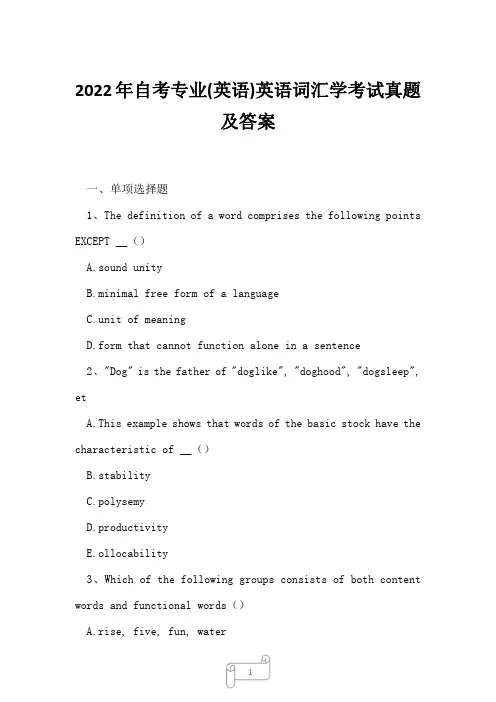
2022年自考专业(英语)英语词汇学考试真题及答案一、单项选择题1、The definition of a word comprises the following points EXCEPT __()A.sound unityB.minimal free form of a languageC.unit of meaningD.form that cannot function alone in a sentence2、"Dog" is the father of "doglike", "doghood", "dogsleep", etA.This example shows that words of the basic stock have the characteristic of __()B.stabilityC.polysemyD.productivityE.ollocability3、Which of the following groups consists of both content words and functional words()A.rise, five, fun, waterB.ten, but, red, ofC.of, is, in, theD.wind, sun, go, bright4、In Middle English vocabulary, we can find words relating to every aspect of human society, e. g. government, law, food, fashion and so on. Which of the following words does NOT belong to them()A.logB.aconC.JudgeD.Power5、Which of the following statements is NOT true()A.nglish is more closely related to German than FrenchB.Old English was a slightly inflected languageC.Old English was a language of full endingsD.Middle English was a language of leveled endings6、In the early Modern English, Europe saw a new upsurge of learning ancient Greek and Roman classics. This is known in history as __()A.IndustrializationB.lizabethan AgeC.RenaissanceD.Victorian Age7、The word "denaturalization" can be broken down into "de-", "nature", "-al", "-ize", "-anon", each having meaning of its own. These minimal meaningful units are known as __()A.morphemesB.llomorphsC.rootD.stem8、Which of the following is the root of the word "internationalists"()A.interB.nationC.-istD.-al9、Which of the following words is an example of free morphemes ()A.TriedB.eetC.WorkerD.nger10、Which of the following statements is NOT true()A.Prefixation is the formation of new words by addingsuffixes to stemsB.Prefixes do not generally change the word-class of the stemC.Prefixes only modify the meaning of the stemD.Present-day English finds an increasing number of class-changing prefixes11、Among the following words, __contains a prefix of time and order()A.x-wifeB.vice-chairmanC.oreheadD.maltreat12、"A green hand" means an "inexperienced person", not a hand that is green in color. In this sense, we can judge that "a green hand" is a __()A.morphemeB.proverbC.ompoundD.ree phrase13、The following words are onomatopoetically motivated words EXCEPT __()A.angB.miniskirtD.hiss14、When we say the "mouth" of a river, we associate the opening part of the river with the mouth of a human being or an animal. In this sense, the word "mouth" conveys __()A.onomatopoeic motivationB.morphological motivationC.semantic motivationD.tymological motivation15、"Black" is a kind of color but its meaning is obviously affected when it occurs in such phrases as "black coffee", "black market", etc.This example demonstrates __()A.grammatical meaning of a word becomes important only when it is used in actual contextB.ffective meaning varies from individual to individual, from culture to cultureC.stylistic difference is especially true of synonymsD.ollocation can affect the meaning of words16、"The front of the head" is the __meaning of the word "face ()A.erivedB.primaryD.secondary17、Homonyms are generally words different in __()A.soundB.spellingC.ormD.meaning18、__share a likeness in denotation as well as in part of speech()A.SynonymsB.ntonymsC.HomonymsD.Hyponyms19、Word-meaning changes by the following modes EXCEPT __()A.xtensionB.upgradationC.specializationD.transfer20、The word "meat", which originally meant "food", but now has come to mean "flesh of animals", is an example to illustrate __of meaning()A.generalizationB.narrowingC.egradationD.levation21、The process by which words rise from humble beginnings to positions of importance is called __of meaning()A.xtensionB.narrowingC.transferD.levation22、In __context the meaning of the word is often affected and defined by the neighbouring words()A.xtra-linguisticB.non-linguisticC.lexicalD.grammatical23、__gives rise to ambiguity in the sentence "I like Mary better than Jean()A.PolysemyB.HomonymyC.Non-linguistic contextD.Grammatical structure24、What kind of context clue is used in the sentence "Perhaps the most startling theory to come out of kinesics, the study of body movement, was suggested by Professor Bird Whistell"()A.xplanationB.efinitionC.xampleD.Synonymy25、"Diamond cut diamond" is an idiom, which reflects __()A.the constituents of idioms can‘t be replacedB.the word order can‘t be invertedC.the constituents of an idiom can‘t be deletedD.many idioms are grammatically unanalysable26、"Jack of all trades" is an idiom __in nature()A.verbalB.nominalC.djectivalD.dverbial27、"Turn on" and "turn off" are antonymous idioms, resulting from __()A.replacementB.dditionC.shorteningD.position-shifting28、__dictionaries involve the most complete description of words available to us()A.UnabridgedB.eskC.PocketD.Linguistic29、Collins COBUILD English Usage (1992)is a(n)__dictionary()A.unabridgedB.ncyclopedicC.ilingualD.specialized30、You can find the real English equivalents to some Chinese items in __()A.hinese-English Dictionary (Revised Edition)(1995)B.Oxford Advanced Learner's Dictionary of Current English with Chinese TranslationC.New English-Chinese DictionaryD.Longman Dictionary of Contemporary English with ChineseTranslation二、填空题题1、The English vocabulary can be classified by different criteria and for different purposes. Words may fall into content words and functional words by __2、The world has approximately 3000 (some put it 5000)languages, which can be grouped into roughly 300 language families and on the basis of similarities in their basic word stock and __3、Morphemes which are independent of other morphemes are considered to be __4、According to the __which affixes occupy in words, affixation falls into prefixation and suffixation5、Conceptual meaning is the meaning given in the dictionary and forms the __of word-meaning6、From the diachronic point of view, __is assumed to be the result of growth and development of the semantic structure of one and same word7、The word "picture" originally denoted only "painting", but now has come to include "drawings" and even "photographs". This is an example to illustrate __8、Linguistic context can be subdivided into lexical contextand __context9、Idioms each are a semantic __,though each consists of more than one word10、Encyclopedic dictionaries can be further divided into __and encyclopedic dictionaries三、名词解释题1、neologisms2、stem3、reference4、degradation5、true idioms四、简答题1、leorn-ian-Tern-en->learn The above is the development of the word "learn" from Old English through Modern English to Middle English. What can be concluded from the above example from the viewpoint of development of English vocabulary2、What is affixation3、Tell the difference between perfect homonyms and polysemants so far as semantic relatedness is concerned4、Guess the meaning of the underlined word in the following sentence and tell what context clue is used. Indian artists were more active in the quattrocento than in the sixteenth centurywhich followed五、论述题1、Explain full conversion and partial conversion by taking "drinkables" and 查看答案【二、填空题题】1notion2grammar3free4position5core6~10点击下载查看答案【三、名词解释题】1neologisms are newly-created words or expressions, or words that have taken on new meanings.2a stem can be defined as a form to which affixes of any kind can be added.3Reference is the relationship between language and the world,In other words on1y when a connection has been established between the linguistic sign and a referent, i. e. an object, aphenomenon, a person, etc. does the sign become meaningful4Degradation or peroration of meaning is the opposite of semantic elevation. It is a process whereby words of good origin fall into ill reputation or non-affective words come to be used in derogatory sense.5Idioms consist of set phrases and short sentences, which are peculiar to the language in question and loaded with the native cultures and ideas. The true idioms of a language share three common features that differentiate them from plain andsimple collocations: (1) They are not compositional, (2) Their words are not substitutable, and (3) They are not modifiable. 【四、简答题】1In modern English, word ending were mostly lost with just a few exceptions .It can be concluded that English has evolved from a synthetic language(Old English)to the present analytic language.本题考查其次章印欧语系词汇变化的相关内容2Affixation is generally defined as the formation of words by adding word-forming or derivational affixes to stems. This process is also known as derivation, for new words created in this way are derived from old forms.本题考查第四章英语构成词缀法的概念的理解3The fundamental difference between homonyms and polysemants lies in the fact that the former refers to different words which happen to share the same form and the latter is the one and same word which has several distinguishable meanings。


2005年广东暨南大学语言学专业考研真题
一、名词解释
1.音素
2.音位
3.音节
4.义素
5.义项
6.语素
二、简答题
⒈为什么说”说话只能在有限和无限,自由和不自由的矛盾中运行?”(5分)
⒉划分和归纳音位的主要依据(原则)有哪些?(6分)
⒊外语学习中的句型”替换”联系是按语言学什么原理设计的?(6分)
⒋基本语法结构有哪五种?各自概括的语法意义是什么?提供语法形式的手段主要有哪几种?(9分)
⒌用变换分析法说明以下句子在句法意义上的差异?(6分)
①台上做着主席台
②台上唱着戏
③台上摆着酒席
三、论述
从汉字长期停留于意音文字阶段看文字体系变革的条件?
四、解释词语
1.亟请于武工
2.女实征之
3.观其辟丸
4.下臣不兴,属当戎行
5.食以草具
五、阅读下面一段材料,并回答下面问题
郑玄字康成北海高密人也八世祖崇哀帝时尚书仆射玄少为乡啬夫得休归尝诣学官不乐为吏父数怒之不能禁遂造太学受业师事京兆第五元先始通京氏易公羊春秋三统历九章算术又从东郡张恭祖受周官礼记左氏春秋韩诗古文尚书以山东无足问者乃西入关因涿郡卢植事扶风马融
融门徒四百余人升堂进者五十余生融素骄贵玄在门下三年不得见乃使高业弟子传授于玄玄日夜寻诵未尝怠倦会融集诸生考论图纬闻玄善算乃召见于楼上玄因从质诸疑义问毕辞归融喟然谓门人曰郑生今去吾道东矣
1.郑玄注过的四种先秦古籍
2.加注标点并译为现代汉语。
Review: Processes of word formation: 1. Derivation (prefixation and suffixation) 2. Compounding 3. Blending 4. Back-formation 5. Initialism ( abbreviation and acronyms) 6. Clipping 7. Aphesis 8. Analogy 9. Reduplication 10. Words from proper names
了解其构词过程并用英文解释其意思 anonymous process: derivation meaning: unknown by name
agnosticism process: derivation meaning: Agnosticism is the belief that it is not possible to say definitely whether or not there is a God.
agony aunt process: compounding meaning: someone who writes an agony column
agony column process: compounding meaning: a part of a newspaper or magazine in which someone give advice to readers about their personal problems.
ambidextrous process: derivation meaning: able to use either hand equally well
antidisestablishmentarianism process: derivation? meaning: ? rare opposition of the disestablishment of the Church of England
baby shower process: compounding meaning: a party given for a woman who is going to have a baby, at which her friends give her presents for the baby.
boomerang kid process: compounding meaning: an adult child who returns home to live with his or her parents after being away for some time
bridal shower process: compounding meaning: party for woman who will get married soon
Electra complex process: Words from proper names meaning: a young girl’s unconscious sexual attraction to her father
euphemise process: derivation meaning: to speak in euphemisms or refer to by means of a euphemism
euthanize process: derivation meaning: to kill an animal in a painless way, usually because it is very sick or old
flattery process: ? meaning: praise that is not sincere, especially in order to obtain something from somebody.
flim-flam process: reduplication meaning: information or ideas that are not true or seem very stupid
Frankenfood process: words from proper name meaning: food that has been genetically modified
greed process: back-formation meaning: a strong desire for more wealth, possessions, power, etc. than a person needs
henpecked process: compounding meaning: a man who people say is henpecked has a wife who is always telling him what to do, and is too weak to disagree with her
hyperprotectiveness process: derivation meaning: too anxious to protect somebody from being hurt, in a way that restricts their freedom
illegible process: derivation meaning: difficult or impossible to read
impeccable process: derivation meaning: without mistakes or faults
fetus-napper process: compounding meaning: ?
motherese process: derivation meaning: a simple style of language of the type that parents use when speaking to their child MRI Process: abbreviation Meaning: Magnetic Resonance Imaging
CPI, CPR, DPT, GRE Process: abbreviation CPI: consumer price index CPR: cardiopulmonary resuscitation DPT: diphtheria-pertussis-tetanus GRE: Graduate Record Examination
Narrowcaster Process: analogy Meaning: the person who send information by television or the internet to a particular group of people
Oedipus complex Process: words from proper name Meaning: feelings of sexual desire that a boy has for his mother and the jealous feelings towards his father that this causes OPEC, APEC, TOEFL Process: Acronyms OPEC: Organization of Petroleum Exporting Countries APEC: Asia-Pacific Economic Cooperation TOFEL: The Test of English as a Foreign Language IELTS: The International English Language Testing Systemouster
ouster process: derivation meaning: the act of removing somebody from a position of authority in order to put somebody else in their place
pecking order process: compounding meaning: the arrangement of people according to their status or power
pharmer process: aphesis ? meaning: A recreational drug user whose primary drug category of choice is pharmaceuticals, either over-the-counter or prescription. play favorites process: compounding meaning: show favoritism towards someone or something
polymath, polyhistor process: derivation polymath: a person who knows a lot about many different subjects polyhistor: a person with broad knowledge
Procrustean bed Process: words from proper name Meaning: an arrangement or plan that produces uniformity by violent and arbitrary measures
rep process: clipping meaning: a person who speaks officially for a group of people, especially at work
rehab process: clipping meaning: the process of helping to cure somebody who has a problem